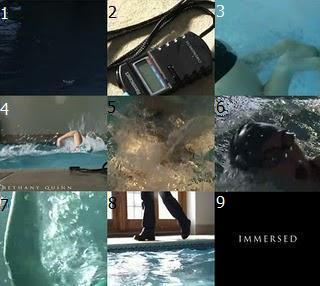-When we arrived at the location, on time, after creating a “shot list” (which helped us to organise ourselves for the day ahead of us) and gathering together all the equipment we needed for the day.
-For the "shot list" we went through our story board writing down the number of the shots which had the camera in the same position as another shot so that we wouldn't have to repeat the same shot several times.
The Shot List looked something along the lines of this;
1 (shot of water)
2 (above shot of girl diving)
6, 12 (swimming along pool from side)
4, 17, 18, 24 (underwater shots)
3, 9 (Close-up of girl’s face while swimming)
10 (close up of feet kicking)
13 (wide shot of girl swimming towards stop watch)
14, 16 (of girl looking at stop watch from side of pool)
15 (POV from girl of stop watch)
19 (close up of bottom of opening door)
20, 22, 23 (following shots of Father’s feet and of father standing)
21 (wide shot of girl swimming)
25 (head on shot of girl coming to end of pool)
26, 28 (POV from father)
27 (POV from girl)
29 (girl getting out of pool)
31 (girl putting on towel- medium shot)
The photo above is of us using our shot-list which is in the folder we created. The folder consisted of the story-board, the cast-list, location photos, letters of permition, the plot etc.
-We began as soon as we had set up the equipment and had the team and actors were “standing by”.
The above photo is of the tracks which we layed down for our tracking shot.
The above photo is of me setting up the tri-pod onto the track for the tracking shot.
When we did a practice shot we realised that the camera was much too high for our ideal shot.
We then decided to tape the camera to the bottom of the tri-pod in order to get the shot we'd hoped for. However, we found this shot diffiuclt as we wanted to assure that there was balanced camera movement and wanted tothat the actors feet were in frame the whole time. Finally, after several takes we finally got the right shot.
-I enjoyed filming as I could remeber everything we were initially taught about camer-work. It was also very exciting as I learnt how to create a slow-motion shot.
The photo to the right is of a wide-shot through the camera.
The photo to the left is of me filming the wide-shot of Bethany swimming in the pool.
-We were happy with our choice in actors as Bethany, in particular, was very easy to work with. Even though she had to do a lot of continuous swimming she worked her hardest in order to not waste shooting time.
The photo above is of me talking to bethany whilst the group is preparing for the next shot. I realised the importance of assuring that the actor knows what the crew's intentions are, before the shot, in order for them to give it their best effort. I learnt that communication between the actor and the crew is very important.
Above is a photo of bethany. We assured that she was comfortable/ ready to begin the next shot as it can be very tiring swimming length after length without a proper break. By giving Bethany this time for a "breather" it allowed her to perform her best leaving Bethany and crew very happy with her work at then end of the day.
-On the day, as we were seeing the location first-hand for the first time, we came up with lot of new ideas for shots which we were very happy with.
e.g an ECU underwater shot of Bethany's hands (as shown below) and body as she is swimming which was very disorientating to the audience and added to the unnerving aspect of the sequence.
-We worked very well together as a group and found that our planning helped us hugely in terms of organisation as we finished with time to spare.
The photo above is of us planning which shots to do at what time and when would be an appropriate time for breaks.
Problems which we experienced on the day were;
- Some shots which we had originally planned to do wouldn't be possible as we were seeing the location, first hand, for the first time.
e.g an underwater shot of the girl diving into the pool as the length and width of the pool wasn't large enough to create the sought after shot.
- The lighting in the room constantly changed as we were using natural lighting (the sun).
e.g we had difficulties with the exposure setting on the camera as the lighting could change mid-shot and then the exposure would be too high. We also noticed that this would create problems for us later in editing as the lighting would change throughout the sequence.
This is a picture of a friend who we asked to hold a towl up to the window in order to block the sunlight so that the exposure didn't change during a shot. This was a done as a last resort because we hadn't thought about problems with natural lighting in our preperation.
In Conclusion, I learnt many things, some of which to do again and others never to do again. It was a great exeperience and I am looking forward to editing the shots to creat my thriller sequence.
































